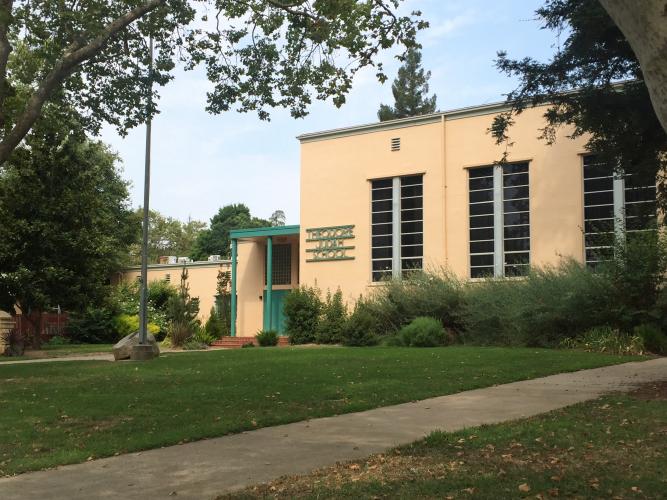History
History
Part of the East Sac Neighborhood History for 95 years and Counting!
Historical Significance
Theodore Judah is the oldest continuously operating elementary school building in the City of Sacramento. The school was built in two separate stages under the Federal Public Works Administration (PWA) program in the years between 1937 to 1939. It is an example of both the very basic depression era architecture and the implementation of the PWA’s objective to provide jobs and build community infrastructure. Theodore Judah is the only such elementary school example in the city.
New School Opens
The school open January 26, 1927 as a one-room wooden bungalow.
The previous spring, local parents met in the bleachers of the
McKinley Park baseball field to begin their successful effort to
petition the Sacramento City Board of Education for a
neighborhood school. The board agreed and accepted a lease
purchase offer for 3.5 acres for $1,000. The site was so remote
that a city survey marked over one mile away at the intersection
of Alhambra and “H” Street was used as the starting point to
locate the property.
A wood frame bungalow with a pot-bellied stove and two drop cord
lights was placed on the site and a temporary footbridge was
built to afford access over a 50-foot drainage slough on the
south side of the school.
The School Name Changed
Thus the “David Lubin Annex” (soon renamed Theodore Judah) school opened with five students and a substitute teacher from David Lubin. One of the most important school rules prohibited the feedings of the cows and horses in the adjacent pastures. Flies were a significant problem and distraction for the students. A petition requesting window screens was rejected by the school board in the spring of 1927. Cost was probably the reason, but a comment from the meeting deserves mention as an example of bureaucratic logic. The concern was raised that “…once the flies got in the building they wouldn’t be able to get out.”
10 Years as a Temporary School
For 10 years, Theodore Judah School remained an officially designed “temporary” school by the school board, with the students to eventually to return to the David Lubin School. During this period additional bungalows were added to accommodate the increasing enrollment. The city continued to grow toward the east and many of the distinctive homes that grace the McKinley Park area were built during that time. This fact coupled with continued effective advocacy by Mrs. Mabel Bone and other residents resulted in a School Board decision to build a permanent school in early 1937.
Permanent School Built
Despite the need for a permanent school, the school district did not have the money to build the school with its budget and depended on the PWA to pay its 45% share. A delay in the receipt of the federal contribution, coupled with the lack of any district reserved monies created a temporary financial crisis prior to the construction of the first unit. The second unit was built in the winter months of 1938 to 1939 as a PWA project. A third unit was constructed in 1948, and in subsequent years additional portable buildings, including a full-service cafeteria unit were added to the site.
Historical Designation
The move for nomination to the Sacramento Historic Register began
several years ago when Annette (Barudoni) DeGlow (Class of 1952)
was asked by the former principal of Theodore Judah to put
together a slide presentation for the magnet school program. She
agreed and during their preparation discovered the school would
be 50 years old in 1989. She had made what she described as a
sure bet on something with her lifelong friend and fellow alumnus
Robert Bone (Class of 1940). The wager was his assistance in
putting together a 50th anniversary Open House for the school. He
lost, and Mrs. DeGlow and Theodore Judah school won.
A time capsule containing many cards from the alumni, and the
original nomination papers for the historic designation was
inserted into the schools history wall. The contents were deeded
to the Sacramento History Center to be opened in 2027. They were
taught the school’s history and were made aware of the plan to
seek designation as a historic site.
The three main reasons for the historic designation were
- It is a significant and integral part of Sacramento history.
- It is a significant example of 1930’s depression-era school construction, engineering, and architecture.
- It is the oldest continuously operating elementary school building in the city.
Historical Character Remains
Architect Charles F. Dean, whose firm worked on Sacramento’s
Memorial Auditorium and other local landmarks, designed Theodore
Judah Elementary.
The school’s main building is constructed in a ground-hugging,
horizontal design. Inside, it boasts mahogany paneling, glass
bricks, tiled water fountains and porthole windows on the
auditorium doors. The original paint scheme, apricot with
sea-form green trim, was restored.
Today, many symbols of the schools historical character and charm
remain intact. From the original hinged teacher’s mailboxes in
the front office, the doors with their rounded porthole designs,
the radiators in the halls and in classrooms and the smoke stack
from the original incinerator.
Placement on the registry doesn’t guarantee the school will never
be razed, but it does ensure a more stringent review process if
demolition ever is contemplated.
Source
- Theodore Judah School On the Verge of Making Local History, Capitol Weekly, Anne Marder, date unknown
- History Not Just Class At School, Neighbors, Walt Yost, 5/12/1994.
- Theodore Judah Steps Into History: ‘30s Art Deco Design Campaign by Alumni Put School In Registry, Sacramento Bee, Jan Ferris, date unknown.

